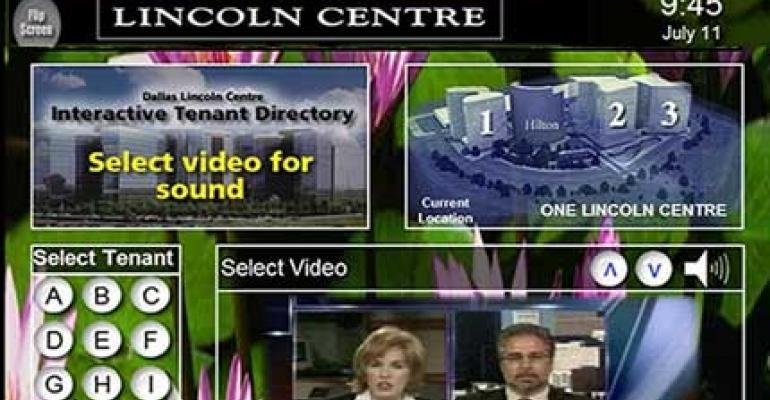A growing number of Class-A office owners in big cities like Dallas and Manhattan are using digital signage to spiff up their lobbies, improve service for tenants and visitors and, in some cases, to create revenue.
“We’ve seen a tremendous improvement in the technology in both the hardware and applications,” says Jim Young, founder of CEO of real estate technology trade organization Realcomm. The newest digital signs can function as two-way video communications stations designed to enable visitors to speak to — and see — tenants from the lobby screen and providing a way for tenants to respond to a building emergency. The revenue comes from advertising spots that pop up when the screen is idle.
“The traditional method of displaying a tenant directory is financially inefficient and provides nothing in the way of a customer service orientation,” says Young. Realcomm-sponsored research pegs the average cost to add a tenant’s name to a conventional office lobby directory at $400—even though the new tenants’ name is often misspelled.

Several U.S.-based and offshore companies design and sell digital signage to the commercial real estate industry. Many of these companies have been formed within the past five years. One new player, Hong Kong-based 1-2-1 View Corp., designs and installs digital signage, chiefly at retail and government buildings, while Fort Lauderdale-based WireSpring Technologies creates self-serve kiosks. Digital signage is also taking hold in the retail sector, though the focus tends to be less on navigation than pure revenue generation through advertising spots.
One Dallas-based digital signage firm, Nexus Media Inc., has installed its monitors in a dozen large-scale commercial properties nationwide. The firm offers tenant directories enhanced with such features as tenant Web sites and wayfinding applications. Rob Flint, sales manager, says that future Nexus screens will hook up to a live concierge who can answer questions from a remote location. Both applications can help landlords trim operating expenses by having fewer lobby personnel.
“Visitors need information, but landlords don’t necessarily want them hounding the security guards,” says Flint. “Our signs enable them to get in and get out efficiently, plus these signs make it clear to visitors that the landlord is serious about new technology.” Flint is reluctant to provide costs since he claims that each job requires custom work on the type of signage and menu of applications.
Management at the 1.6 million sq. ft. Lincoln Centre complex in Dallas hired Nexus to install 6 screens back in 2004. According to Karen Kestler, who works for building manager Cousins Properties, the signs made her life easier from the start. The reason: Cousins previously bought backlit filmstrips to list the names of the roughly 150 tenants in the three-building complex. Kestler says that each time a tenant left or moved in, Cousins had to buy a new filmstrip and pry open an unwieldly steel box to replace it.
“We don’t have to bother with that anymore. Plus, we knocked down the wall where the old tenant directory was housed and put in a seating area below the monitor,” says Kestler. Cousins declined to comment on how much it spent on the technology and there have been no recent studies on digital signage use in commercial office buildings to estimate a sum. “Next time you visit a big expensive skyscraper with a boring lobby and an outdated plastic tenant directory, ask yourself what makes a building a great place to work,” says Young of Realcomm. “[Is it] shiny marble floors or communication systems that are compatible with 21st century living?”
| RESOURCES | ||||||||
|

